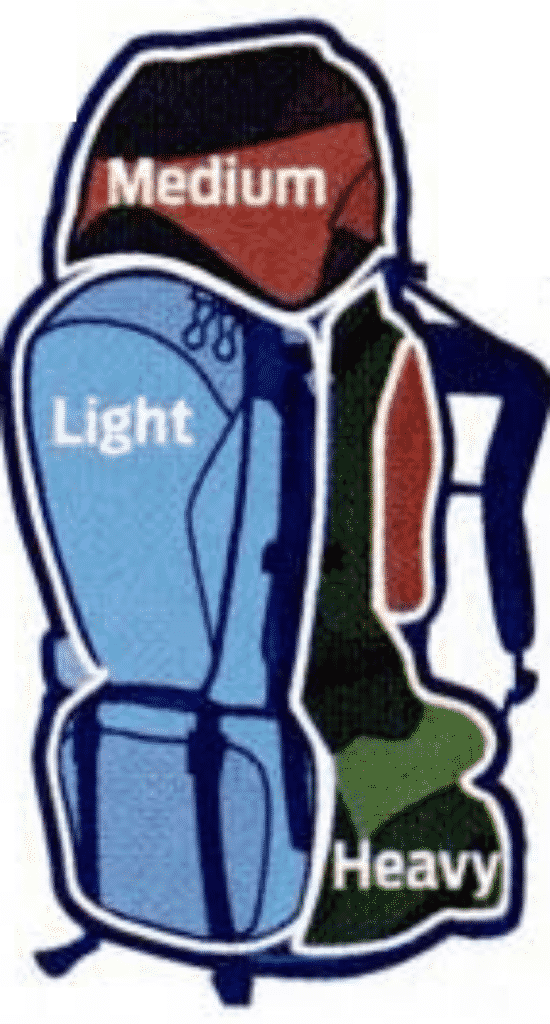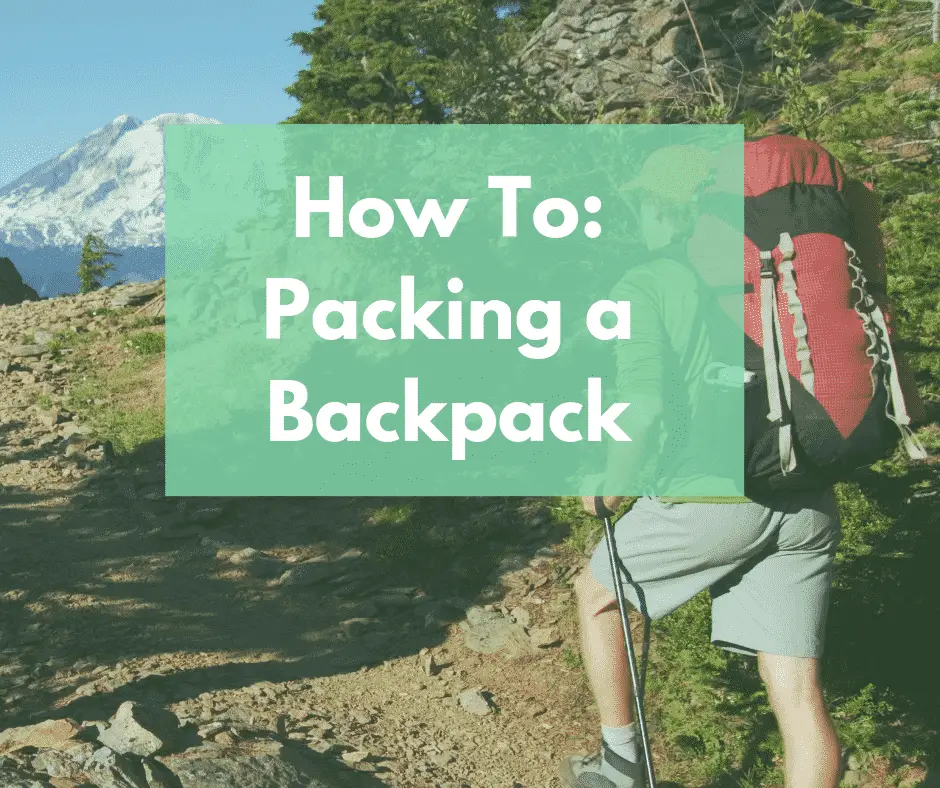Backpacks have really come a long way since I was a child. Most of us have ditched our external frame packs for modern high-tech packs. With modern packs we can carry more gear longer, farther and faster than ever before. Even though the packs have changed the same basic rules of packing gear still applies.
When properly packed hiking backpacks can carry a surprising amount of gear. While there’s no one right way to pack, do it wrong and you’re sure to notice. So how do you pack to ensure a comfortable hike all day long?
Table Of Contents
Packing Your Backpack
You’re going to be carrying your pack for days or even weeks at a time. When going on long backpacking trips balance and comfort are absolutely crucial. Not only will you be more comfortable It’s also going to be safer. With a well loaded pack you’re going to keep your balance and prevent nasty falls.
Remember that you should always pack for both comfort and convenience. Your gear needs to be packed comfortably without throwing off your center of gravity and you should be able to conveniently get at all your essentials.
Packing For Comfort
The best way to maintain your comfort is to maintain your center of gravity. Try to pack all your heaviest and densest gear close to your body. All the heavy stuff should be above your hips and low on your back. All your heaviest gear should end up higher up your back close to your shoulder blades.
Packing For Convenience
Layer all your gear so the most used items are close to access points. You aren’t going to need a sleeping bag until you make camp so that goes towards the bottom. Jackets and high use items should be near the top and outer edges of your pack.
Main Backpack Zones

A well loaded pack should feel stable/balanced when resting on your hips. You shouldn’t feel any sway in your pack as you climb and hike.
As a general rule you want to carry all your heavy/bulky gear in the bottom of your bag. Heavier gear needs to stay above your hips and close to your body. With lighter stuff on the outside of your bag.
- Bottom Zone: Fill the bottom of your bag with heavy and bulky gear. If you don’t need it until camp place it in the bottom of your bag.
- Core: Dense and heavy items need to be close to your body. Heavier gear should never be away from your body.
- Top: Keep anything you might need on the trail at the top of your bag. Make sure you pack extra clothes and rain gear at the top of your pack.
- Accessory Pockets/Loops: Good for everything that you regularly use. Use the loops to lash on long and bulky items.
Figuring Out Your Pockets
Every company is going to have slightly different designs, but they all have one thing in common. Hiking backpacks always have a ton of different pockets for organizing your gear. All these extra specialty pockets are designed to keep all your essentials close-by without throwing off weight.
- Brain(AKA Top Pouch): A backpacks upper most pocket is referred to as the Brain. This is where you want to carry everything that you could possibly need on the trail. Store all your navigation tools, snacks, lights ETC in this easy to use pocket. Look for a top lid with enough room for all your on the trail daily essentials.
- Front Pouch(Kangaroo Pouch): Store all your rain gear in the waterproof front pouch on your bag. You’ll be able to quickly access it in a downpour and it will keep all your other gear dry. Try not to put heavy items in your front pocket because it will throw off your center of gravity.
- Hip Belt Pocket: The hip belt pocket is where I keep all my snacks, gum, lip balm, phone ETC. You don’t want to take your pack off every time you need a snack.
- Water Bottle Pocket: Each side of your pack should have a water bottle pocket. When testing out your pack make sure you can reach the water bottle without taking off the pack.
Fill Extra Space
Try to fill in all those little nooks and crannies at the bottom of your bag. Make sure you have a solid, stable load that’s balanced on both sides. Use the compressions straps to prevent it from shifting as you hike.
Loading Your Hiking Backpack
Bottom of The Pack
At the bottom of your pack store anything you won’t need until making camp. The bottom of your pack should be filled with soft and light gear that won’t pull on your back. Plus it creates natural shock absorption to protect all your gear. Anything heavy should be kept above your hips close to the body.
- Sleeping Bag: Your sleeping bag is always the last thing you need in camp so it should be at the bottom of your bag. Most packs have a compartment sized specifically for a bag.
- Sleeping Pad: roll your pad into a tiny shape and stick it above the bag.
- Sleeping Clothes: Try to stick your sleeping clothes into the bottom of your bag. The bottom of your bag is going to be the driest part of your bag.
Core Items
All your heavy gear needs to be kept close to your body. Dense cooking gear, meals, camping stove, hydration pack and bear canisters. Packing all your heavy gear close to the body will stabilize the load.
Placing heavy gear too low will make your pack sag, while too high will tip you over. Use soft items to fill in all those gaps and prevent gear from shifting.
- Cooking Gear: stoves, fuel, pots/pans
- Food and scented items in a Bear Canister(my favorite bear canister)
- Water Reservoir or Hydration Bladder(make sure you fill up the bladder before filling your bag)
Wrap Up Your Heavy Gear
You should definitely wrap up all your heavy gear in soft items. Use your tent’s footprint/body/rainfly and extra clothes to compact all the clunky gear.
Top of Pack
In the top of your bag store all the bulky gear that you could need in a hurry. You shouldn’t have to rummage through your bag to put on a jacket or rain gear. Always carry your first-aid kit, toiletries and water filters at the top of your bag.
- Lightweight Jackets, pants and insulated jackets
- Rain Gear
- First-Aid Kits(Here’s a Really Nice Yet Affordable First-Aid Kit)
- Water Filters and Purifiers
- Toiletries(trowels, Toilet Paper, Used TP Bag)
Pockets
Every pack is going to be different, but they should all have a few easy to access pockets. Fill these pockets with everything you could need on the trail. Think along the lines of maps, compass, snacks, flashlights ETC.
- Maps/Compass/GPS
- Sunscreen, Bugspray
- Hats/ Sunglasses
- Flashlights and Headlamps
- Snacks and Water Bottles
- Car Keys, Phone Basic Essentials
Loops and Lash-On Points
Your loops and lash on points are for storing your awkward and long gear. Think along the lines of Trekking poles, Tent Poles, ropes and anything else that won’t easily fit into your bag. During the winter you’ll probably need to lash on some crampons and a ice axe.
Most packs are going to have a few extra fasteners and lash-on points to attach your gear. You can always add a few extra carabiners and compression straps to load up extra gear. Just remember to minimize how much junk you place on your bag so it doesn’t snag on trees and branches.
Avoid Overpacking
Beginners always seem to overpack making it difficult to keep up on the trail. All that extra weight is going to severely slow you down on the trail. Remember that less is more and once you’re on the trail you cant shed gear.
The easiest way to cut weight is to lay everything out on your bed and separate the essential items from the luxury items. Cut out most of those extra items that you don’t really need anyway.
If you still have room in your pack add a few extra luxury items and repack. Keep ditching and adding items until everything fits.



